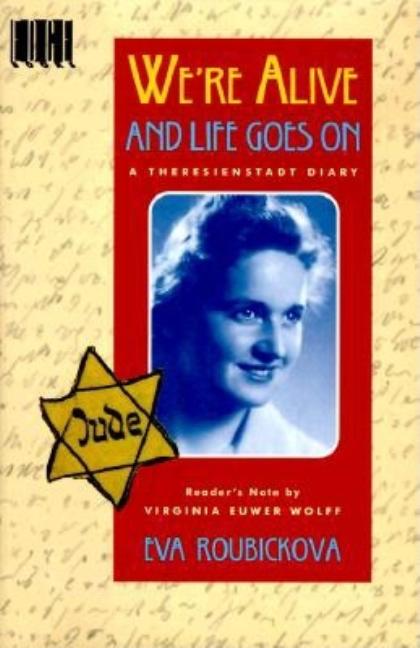Book Descriptions
for We're Alive and Life Goes on by Eva Mandlova Roubickova
From Cooperative Children's Book Center (CCBC)
Theresienstadt (today known as Terezín) was Nazi Germany's "model" concentration camp. Located in Bohemia (now the Czech Republic), this camp, unlike Nazi death camps, kept up a front of "normalcy"for the sake of Nazi propaganda. So there were cafes and theaters. Prisoners heads weren't shorn. Eva Mändlová was 21 years old when she was sent to Theresienstadt in 1941. A Bohemian Jew, Eva kept a diary for the three-and-one-half years she was imprisoned. In it, she details the real experience of life in the prison work camp. Eva and her fellow prisoners only heard rumors about other camps, about the unknown but certain horrors that happened to people who were shipped out of Theresienstadt on transports to Poland. The threat of being placed on one of those transports hung over the heads of Theresienstadt prisoners. It was a fear that became as much a part of Eva's daily life as worry about hunger and illness, and death from one or both; the disjointedness of never knowing when she would be moved from one barracks or living quarters to another; the relief and terror of taking food from a sympathetic German civilian (Would she be caught? How long would it last?). To have family and friends to visit in the camp was a comfort, but every fear that Eva knew for herself was also a fear she felt for those she loved. If she wasn't on the next transport to Poland, her mother or father or cousin or a dear friend might be, and sometimes were. The brutality of Theresienstadt was different in many ways from the brutality of the death camps, but that it was brutal, and chillingly inhumane, is hauntingly clear, and important to understand. Honor Book, CCBC Batchelder Award Discussion (Age 13 and older)
CCBC Choices 1997. © Cooperative Children's Book Center, Univ. of Wisconsin - Madison, 1997. Used with permission.
From the Publisher
"It's a terrible feeling to see the fate of thousands of people dependent on a single person. . . . It seems like a mass judgment to me: life or death."
On December 17, 1941, twenty-year-old Eva Mándlová arrived at the Nazi's "model" concentration camp, Theresienstadt. From that day until she was freed three and a half years later, she kept a diary. At times sweet and personal, at times agonized and profound, Eva is a human voice amidst inhuman evil.
Through Eva's eyes, the camp sometimes "even resembles normal life," as she makes friends and talks with Benny, or Egon, or Otto. But at any moment, anyone may be "selected" for a transport to "Poland." No one ever returns from "Poland."
Never before published, Eva's diary is a true-life Sophie's Choice in which each day brings impossible decisions. As a Gentile man inexplicably helps her, Eva must decide who should share her bounty. As close friends and loved ones are sent away, she has to decide, over and over again, whether to ask to join them on their final journey.
On December 17, 1941, twenty-year-old Eva Mándlová arrived at the Nazi's "model" concentration camp, Theresienstadt. From that day until she was freed three and a half years later, she kept a diary. At times sweet and personal, at times agonized and profound, Eva is a human voice amidst inhuman evil.
Through Eva's eyes, the camp sometimes "even resembles normal life," as she makes friends and talks with Benny, or Egon, or Otto. But at any moment, anyone may be "selected" for a transport to "Poland." No one ever returns from "Poland."
Never before published, Eva's diary is a true-life Sophie's Choice in which each day brings impossible decisions. As a Gentile man inexplicably helps her, Eva must decide who should share her bounty. As close friends and loved ones are sent away, she has to decide, over and over again, whether to ask to join them on their final journey.
Publisher description retrieved from Google Books.


